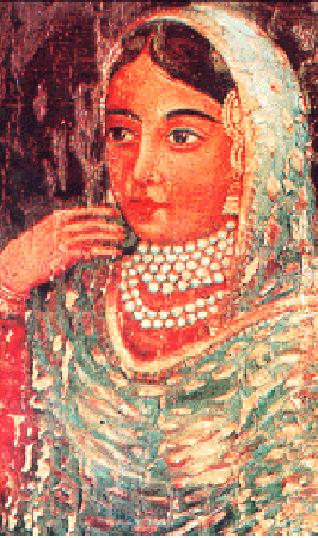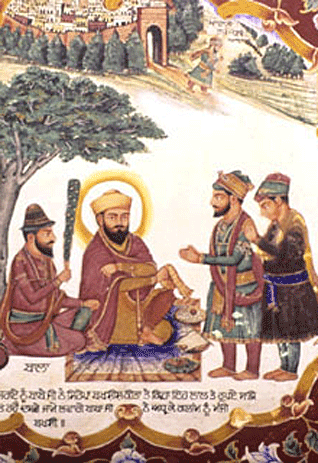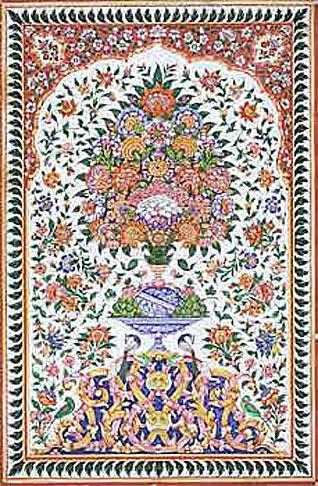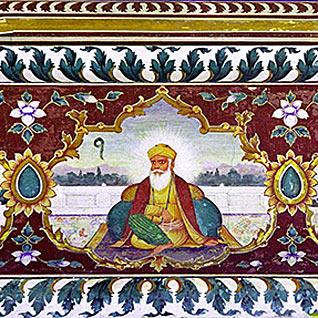Architecture
Adorning the Walls
by KANWARJIT SINGH KANG
The art of wall painting had been commonly practised in 18th century Punjab as a tradition way of decorating shrines and homes. It flourished under the Sikhs, struggled for existence in the violent social changes that came in the train of the British and succumbed to the great transformation that was brought about in Punjab by the turn of the century.
Although the Sikh "unitarian form of belief and the ban against image-worship left very little scope for the development of the visual arts for needs of religious worship", yet the primitivist need of the people for images flouted the taboos of faith, and brought about many paintings. They spent large sums of money for the beautification of their Gurdwaras.
In Maharaja Ranjit Singh's time, as Sikhism had royal patronage, the Sikhs began to devote themselves to magnificence and splendour. The walls of over 700 shrines associated with the Sikh Gurus in Punjab were available for embellishment. Endowments and grants worth thousands of rupees made possible the building of these shrines in pucca masonry.
Representation of the Sikh Gurus constitutes the major portion of themes pertaining to the Sikhs and more than half of the murals portray Guru Nanak and Guru Gobind Singh, the first and the last of the Sikh Gurus.
From among the extant remains of wall paintings in Punjab, the earliest rendering of Guru Nanak is from the late 18th century mural panel in the temple of Sri Nam Dev at Ghoman in district Gurdaspur. By the end of the first quarter of the 19th century, representations of the First Master became much more popular, being based on traditional accounts.
I Guru Nanak sitting with Bala, a chauri-bearer and Mardana, the rebeck player. Under a tree, on which birds - mostly parrots - are shown, he sits in a characteristic meditative pose, not very different from how he is seen in many modern calendar paintings: his back supported by a round pillow, a rosary in his right hand, the left arm resting on the mat on the floor. A typical example of this type of representation is seen in the Bairagi temple at Ram Tatwali, in district Hoshiarpur.
II Another important theme is the Siddha Goshti, Guru Nanak's religious discourse with the siddhas, consisting of a number of ascetics sitting in their hierarchical order. The themes have been best delineated in akhara Bala Nanad, Amritsar, and in the samadh of Baba Khuda Singh at Naurangabad near Tarn Taran. Many times, the Guru appears along with his sons, Sri Chand and Lakshmi Das, sitting respectfully before him.
III The most representative extant series of the Janamsakhis are to be seen in the Gurdwara of Baba Kala Dhari at Una, and in the shrine of Baba Atal, in Amritsar, the former consisting of forty one painted panels. Beginning with the birth of Guru Nanak, the first part of the series illustrates themes from the Guru's childhood, consisting of scenes of the Guru attending school, disagreeing with his teacher's lessons on worldly knowledge, grazing his father's buffalos and cows, feeding the poor and the holy, etc.
As he grows up, he is seen as the keeper of the government stores at Sultanpur; getting betrothed and married; and renouncing the world. Then, he appears as a preacher meeting Malik Bhago and demonstrating the difference between the earnings of the oppressor and those of the honest man. Further on, he is seen with Kauda (the cannibal), Kaliyuga and Wali Kandhari, all of whom he then convinces to relinquish their evil propensities. He is also depicted preaching to the legendary character called Karun, and sleeping, while at Mecca, with his feet pointing towards the Ka'aba.
The series in Baba Atal ends with the Guru appointing Angad as his successor to the Gur Gaddi. The series in the Gurdwara of Baba Kala Dhari at Una also consists of a number of scenes illustrating Guru Nanak's religious discourses with contemporary theologists. The old building of Gurdwara Panja Sahib at Hasan Abdal, now in Pakistan, too, once had murals relating to the Guru's life.
Guru Gobind Singh often appears on horseback, holding a falcon and accompanied by a hound and a few attendants. The best extant wall painting on this theme, which is repeated over and over again, is to be seen in the samadh of Baba Dyal Das at Barnala and in the Golden Temple at Amritsar.
Guru Gobind Singh baptizing the "Five Beloved Ones" is another popular theme and one of its representative examples still survives amongst the wall paintings of the Akal Takht. Paintings depicting him in a sitting posture with an attendant behind are also seen, but not that often. In one of the wall paintings at Gurdwara Gurusar in Bargarhi, district Faridkot, he is portrayed playing dice with Rai Jagga, the chief of Kot Kapura. A mural in the samadh of Baba Mohar Singh at Tanda in district Hoshiarpur represents Guru Gobind Singh, along with his four sons.
Murals depicting other Sikh Gurus show the Guru sitting with an attendant behind, waving a yak's tail fly-whisk or peacock-feather fan. Apart from the well-executed wall paintings of them, extant in the Gurdwara of Baba Kala Dhari at Una, and the Gurdwara of Baba Bir Singh at Nurangabad, they are also to be seen in Raja Sansi in district Amritsar, the Akal Takht, the Darbar Sahib, the Bunga of village Sathiala in Tarn Taran, and Gurdwara Pothi Mala at Guru Harsahai in district Ferozpur. Scenes from the lives of the Gurus were also painted on the walls of a dharamsala of Lehru, a village in district Ludhiana.
Wall paintings illustrating interesting themes related to Guru Hargobind appear on one of the panels in the samadh of Mangani Ram at Amritsar, portraying his religious discourse with Mian Mir. In the Akal Takht, Bhai Bidhi Chand is shown presenting horses to the Guru, which he skillfully brought back from the Governor of Lahore, who had forcibly made off with them earlier. A panel in Gurdwara Pothi Mala depicts Guru Hargobind blessing Mai Sulakhni.
Wall paintings representing Guru Nanak flanked by the rest of the Gurus were painted several times, but the theme portraying all the Gurus in a single panel seems to have come into vogue not earlier than the second half of the 19th century.
Typical examples are to be seen in the samadh of mahant Mangni Ram and akhara Bala Nand, both in Amritsar, in the shivala of Hardhan at Matewal, a village near Amritsar and in the samadh of Baba Mohar Singh at Tanda, in district Hoshiarpur.
Among the paintings that embellished the walls of a palace at Wazirabad built by Maharaja Ranjit Singh, were life-size portraits of the Gurus, from Nanak to Gobind Singh, according to Baron Hugel who saw them there personally.
After the Gurus, in terms of popularity, came themes that depict Sikh martyrs who became victims of Mughal bigotry. The most prominent among them are Ajit Singh, Jujhar Singh, Fateh Singh and Zorawar Singh, the four sons of Guru Gobind Singh. They have usually been illustrated in action in the battlefield, and are best represented in a panel at Gurdwara Pothi Mal at Guru Harshai in district Ferozpur.
A number of other martyrs - Deep Singh, Nena Singh, Gurbaksh Singh and Kharag Singh - adorn the walls of the shrine of Baba Atal. Banda Bahadur, one of the most valiant leaders and martyrs of the Sikhs, after Guru Gobind Singh, has been depicted only once in the Darbar Sahib at Tarn Taran.
The theme portraying Baba Buddha is confined to the wall paintings seen in the edifices in the Majha tract. The whole of this lineage consisting of Bhai Sarwan, Jhanda, Gurdita, Mohar Singh, Shyam Singh, Kahn Singh and Sujan Singh also appears, albeit rarely. Two such series of wall paintings are extant in the Akal Takht and Baba Atal.
Similarly, in Gurdwara Pothi Mala at Guru Harshai, in district Ferozpur, is a series representing the lineage of Sodhis. Many other personages related to the Sikh religion also appear in murals, including Baba Bir Singh at Naurangabad, near Tarn Taran, Bhai Mani Singh in the bunga of village Sathiala at Tarn Taran and Akali Phula Singh in the temple of the Bairagis at Ram Tatwali in district Hoshiarpur.
Nihang Singhs form one of the most interesting themes in the murals of 19th century Punjab. Their way of life is elaborately represented in the paintings. They appear as dvarapalas or guards with drawn swords, beating drums, riding horses and elephants, hunting, fencing, grinding leaves to make intoxicating potions, and the like. Many wall paintings relating to them are extant in the Gurdwara at Bargarhi near Kot Kapura, in the samadh of Rani Jind at Hoshiarpur and in the samadh of Baba Mohar Singh at Tanda. In the Gurdwara Logarh at Dina, in district Faridkot, are to be seen the two most prominent leaders of the Nihangs - Akali Phula Singh mounted on an elephant and Nena Singh riding a horse, their names being indicated in Gurmukhi characters above their heads.
Two paintings, one each in the samadh of Baba Khuda Singh at Naurangabad, district Amritsar, and the samadh of the daughter of Mai Hiran at Bhunga in district Hoshiarpur, depict the Sikh sangat paying reverence to the Guru Granth Sahib.
Sikh themes are also to be seen in the considerable number of paintings connected, one way or the other, with 19th century royalty and nobility. In two paintings, one in the samadh of Baba Maan Singh at Sodhiwala near Zira and the other in the thakurdwara at Bagarian in district Sangrur, Maharaja Ranjit Singh appears, followed by his royal retinue.
The demolished Bungas of the Golden Temple at Amritsar once had splendid wall paintings depicting important events of Sikh history.
In the Lahore palace, a mural is recorded as showing the meeting of Maharaja Ranjit Singh with Lord William Bentinck at Ropar. A mural in the house of Generals Ventura and Allard at Lahore records their reception in the court.
There are also pictures of battles in which the two generals were engaged. The tradition of getting walls painted with themes illustrating warfare was apparently popular among the Sikhs. Houses of the Sikh nobility in district Lahore were embellished with fighting scenes, relating chiefly to conflicts with the Afghans of the North-West Frontier. A wall painting representing the battle of Jamrod is mentioned as among those in the fort of Hari Singh Nalwa at Gujranwala.
The ceiling of Allard's bungalow at Lahore was painted with the emblem of Francese Compo or the Fauj-i-Khas, consisting of the Gallic eagle and the tri-coloured flag, writ large with the name of Guru Gobind Singh.
In a mural in akhara Bala Nand at Amritsar appears Hari Singh Nalwa, inspecting a long row of soldiers. Two adjacent panels in akhara Beri Wala at Amritsar represent Maharaja Ranjit Singh and the Jangi-lat on horseback, facing each other and followed by the Sikh and the British armies, respectively. Sikh and British forces, engaged in fierce battles consisting of many hundreds of soldiers, appear in a wall painting in the temple of Bairagis at Ram Tatwali in district Hoshiarpur.
A considerable number of portraits, some based on life and others on imagination, mostly depicting 19th century Sikh royalty and aristocracy, are to be seen among the extant wall paintings all over the Punjab. In addition, there are references to portraits in written records which describe works no longer surviving.
Among the portraits, Maharaja Ranjit Singh's remains the dominating figure. In one of the frescoes in the Royal Palace in Lahore, he was portrayed in the presence of Guru Nanak with his hands joined in a supplicatory manner. In the scene that represented Ranjit's meeting with the Governor-General of Ropar, in one of the murals of the Lahore palace, the two were depicted facing each other.
The frescoes in the mansion of Avitabile had, among other themes, a portrait of Maharaja Ranjit Singh. A painting in Peshawar portrayed him seated cross-legged with Raja Dhian Singh at his right, while the effiminate and youthful Hira Singh lolled in a careless attitude besides his master.
The description also mentions a crew of whiskered, turbaned figures, portraying Allard, Ventura, Court and Avitabile, the four prominent European officers in the employ of the Maharaja, standing behind the arbiter of their destinies.
Not very long ago, wall paintings representing life-size portraits of Maharaja Ranjit Singh and the princes were to be seen on the walls of the Ramgarhia bunga, especially the pillars facing the Dukh Bhanjani shrine, on the premises of the Golden Temple at Amritsar.
At Ram Tatwali, in district Hoshiarpur, a remarkable painting portrays the Maharaja seated in a chair, while Dhian Singh, Gulab Singh and Suchet Singh, the Dogra brothers, stand with folded hands before their master. A painting with a similar composition survives in the samadh of Baba Mohar Singh at Tanda. In another work in akhara Bala Nand at Amritsar, he is shown with his sons: Kharak Singh, Sher Singh and Nau Nihal Singh. Other interesting murals delineating the Maharaja in different situations are to be seen at Sri Palkian Sahib near Jaura, a village in district Amritsar, in the haveli of Seth Panna Lal Phul Chand Sharda at Ferozpur, in the house of Shri Anant Ram at Tanda, in the Shiv temple at Bhunga in district Hoshiarpur and in the temple of Baba Hari Har at Nur Mahal.
Individual portraits of Sher Singh, Dhian Singh, Gulab Singh, Suchet Singh and Fakir Azizuddin appear in the Bairagi temple at Ram Tatwali. In the Shiv temple at Lasara, a village in district Jalandhar, are two interesting portraits, identified through Persian inscriptions over their heads. One of these depicts Maharaja Ranjit Singh with an attendant, Gulam Moinuddin, while the other shows, interestingly enough, Maharaja Dalip Singh playing the sitar.
The mural in the house of Ventura and Allard, which represented their reception at the Court of Maharaja Ranjit Singh, and which we are told consisted of "many thousands of figures" must have included numerous portrait studies, at least of those who were directly involved. A painting in the house of Shri Kundan Lal at Dasuya portrays General Court and his wife standing with umbrellas held over their heads. The name "Court Sahib Bahadur" appears in Persian script close to the top of the panel.
In the cis-Sutlej states, Maharaja Ranjit Singh and his sardars are replaced as themes by the portraits of local rajas and chiefs. Wall paintings in the diwankhana in Kila Mubarak at Patiala have life-like portraits of Raja Narindra Singh and the other rajas of the Phulkian states, including Sangat Singh, the Raja of Jind. In the Kila Mubarak at Chhachhrauli appear wall paintings portraying local sardars.
Not infrequently, the person in whose honor an edifice was erected was portrayed in a mural panel. A portrait of Baba Bikram Singh Bedi can be seen in his samadh at Amritsar. Depictions of Baba Bir Singh appear in the gurdwaras related to him, both at Raja Sansi as well as at Naurangabad, in Amritsar district.
There is a fine portrait believed to have been of Mohar Singh and one of his associates in his samadh at Lopon, a village in district Ludhiana. Portrayals of Sardar Lal Singh, Bakhshi Mehtab Singh , Baba Khuda Singh and Baba Mohar Singh are extant in their respective samadhs located at Kale Ghanupur near Amritsar, at Dina in district Faridkot, at Naurangabad near Tarn Taran and at Tanda in district Hoshiarpur, respectively.
An interesting fresco in the temple of Mansa Devi at Manimajra, near Chandigarh, portrays Raja Gopal Singh, the builder of the shrine.
Female portraiture was not unknown, but was certainly rare. Lt. Barr mentions Lady William Bentinck, accoutred in white trousers, boots and gold straps, a few paces behind her husband in the scene of Maharaja Ranjit Singh's meeting with the Governor General at Ropar, in one of the murals of the Lahore Palace. At Raja Sansi, a portrait said to have been of Rani Jindan, who was so well known to Sikh miniaturists, is still extant. Another female image in the frescoes of the Bhandari Bola temple at Batala is also believed to be of Rani Jindan. She appears again in one of the portraits in Bairagi temple at Ram Tatwali in district Hoshiarpur.
Edifices related to the Sikhs were often painted with a decorative design known as dehin, executed symmetrically in creeper, floral and bird motifs. It was raised over a base known as gharvanj, an ornamental device involving intricate interspersing of grappling animals and floral patterns. An adornment known as pattha was used around the dehin.
Conversation about this article
1: Rai Jagga (France), October 02, 2007, 4:27 AM.
It is a wonderful article which revives an aspect of the past of Punjab and its colourful history. It would be a pleasure to invite the author for further discussions and research. I have a personal question for the author. We are a family from from Faridkot/Korkapura (of course, now living outside India). Does he have more information about Rai Jagga, which is referred to in the article?
2: Pinaki Attreya (Delhi, India), November 20, 2007, 4:29 AM.
Good and interesting.
3: Aisha Saddiqa (Lahore, Pakistan), March 05, 2008, 1:47 AM.
I found it a very interesting article ... very informative! I am a Graphic Designer and teach at the Lahore Women University; as well, I'm enrolled in the Ph.D program at the same institute.
4: Paramjeet Singh Jaggee (London, United Kingdom), December 26, 2013, 11:14 AM.
There seems to be a lot of history on the internet which is well biased towards the liking and not liking of other people. Why can't people be unbiased and let the facts come to the public's attention and let us all know more about Sikh and Punjab and world history.






